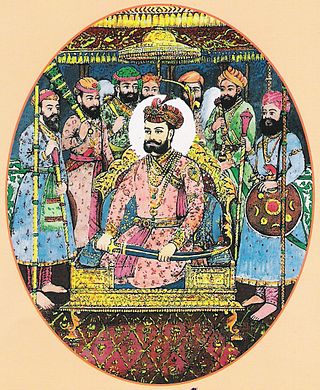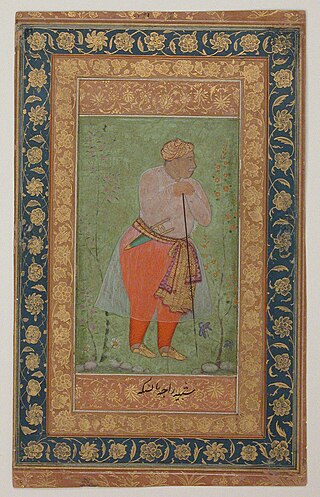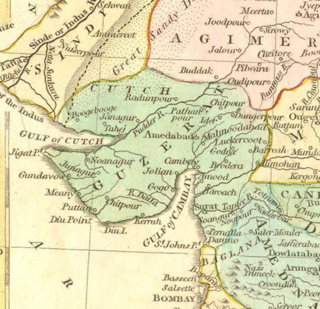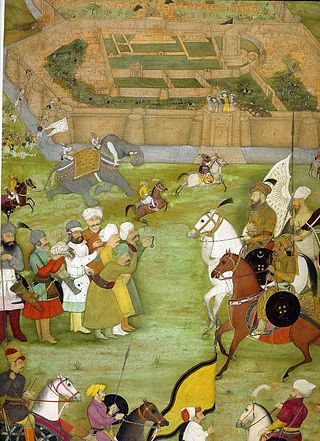
Badakhshan is a historical region comprising the Wakhan Corridor in northeast Afghanistan, eastern Tajikistan, and Taxkorgan Tajik Autonomous County in China. Badakhshan Province is one of the 34 provinces of Afghanistan. Much of historic Badakhshan lies within Tajikistan's Gorno-Badakhshan Autonomous Region in the southeastern part of the country. The music of Badakhshan is an important part of the region's cultural heritage.

The Second Battle of Panipat was fought on 5 November 1556, between Akbar and Emperor Hemu. Hemu had conquered Delhi and Agra a few weeks earlier by defeating Mughal forces under Tardi Beg Khan in the battle of Delhi. He crowned himself Raja Vikramaditya at Purana Quila in Delhi.

Hemu was an Indian king (maharaja) who previously served as a general and Wazir of Adil Shah Suri of the Sur Empire during a period in Indian history when the Mughals and Afghans were vying for power across North India. He fought Afghan rebels across North India from Punjab to Bengal and Mughal forces of Humayun and Akbar in Agra and Delhi, winning 22 battles for Adil Shah Suri.

The Battle of Tukaroi, also known as the Battle of Bajhaura or the Battle of Mughulmari, was fought between the Mughal Empire and the Bengal Sultanate on 3 March 1575 near the village of Tukaroi in present-day Balasore District of Odisha. It resulted in a Mughal victory and greatly weakened the Bengal Sultanate.

RajaMan Singh I was the 24th Maharaja of Kingdom of Amber from 1589 to 1614. He also served as the Subahdar of Bihar from 1587 to 1594, then for Bengal for three terms from 1595 to 1606 and the Subahdar of Kabul from 1585 to 1586. He served in the Mughal Army under Emperor Akbar. Man Singh fought sixty-seven important battles in Kabul, Balkh, Bukhara, Bengal and Central and Southern India. He was well versed in the battle tactics of both the Rajputs as well as the Mughals. He is commonly considered to be one of the Navaratnas, or the nine (nava) gems (ratna) of the royal court of Akbar.

Ghazipur district is a district of Uttar Pradesh state in northern India. The city of Ghazipur is the district headquarters. The district is part of Varanasi Division. The region of Ghazipur is famous mainly for the production of its unique rose-scented Spray called Gulab Jal, and for the tomb of the Governor General of British India, Lord Cornwallis, who died here. His tomb is situated in Western part of City, and is conserved by Archaeological Survey of India.

Ali Quli Istajlu, commonly known as Sherafgan Khan, initially served as the safarchi of Safavids, and later became a Mughal courtier, becoming the jagirdar of Burdwan in West Bengal (1605–1607). He was also the first husband of Nur Jahan (Mehrunissa), who later married Jahangir after Ali Quli Khan's death and became Empress of India and the power behind the emperor.

Adil Shah Suri Pashto عادل شاه سوري was the seventh and final ruler of the Sur Empire. He was the brother in law of Sikandar Shah Suri, who ruled over a region east of Delhi after Sikandar Shah Suri was defeated by Humayun in 1555. He and Sikandar Shah Suri were contenders for the Delhi throne against the Mughal emperor Akbar.
Zamania is a town in the Indian state of Uttar Pradesh. Its municipal council is subordinate to the Ghazipur District. It is also the administrative head of Zamania tehsil,. It is also a very historical town, it derives its name from Ali Quli Khan Zaman, who was also known as Khan Zaman or Zaman Khan, he was a governor of Jaunpur, and Ghazipur during the time of Akbar.

Abu'l-Fath Jalal-ud-din Muhammad Akbar, popularly known as Akbar the Great, and also as Akbar I, was the third Mughal emperor, who reigned from 1556 to 1605. Akbar succeeded his father, Humayun, under a regent, Bairam Khan, who helped the young emperor expand and consolidate Mughal domains in the Indian subcontinent. He is generally considered one of the greatest emperors in Indian history and led a successful campaign to unify the various kingdoms of Hindūstān or India proper.

Daud Khan Karrani was the last ruler of Bengal's Karrani dynasty as well as the final Sultan of Bengal, reigning from 1572 to 1576. During the reign of his father Sulaiman Khan Karrani, Daud commanded a massive army of 40,000 cavalry, 3,600 elephants, 140,000 infantry and 200 cannons.
The Battle of Tughlaqabad was a notable battle fought on 7 October 1556 between Hemchandra Vikramaditya, also referred to as Hemu, and the forces of the Mughal Emperor Akbar, led by Tardi Beg Khan, at Tughlaqabad in Delhi. Hemu's army emerged triumphant in the battle, who thereafter took possession of Delhi and claimed royal status, assuming the title of MaharajaVikramaditya. Following his failure, Tardi Beg was executed by Akbar's regent, Bairam Khan.

Munʿim Khān was a Mughal general under both emperors Humayun and Akbar. He was titled Khān-i-Khānān when Emperor Akbar appointed him as Prime Minister of the Mughal Empire in 1560. In 1564, he became the Subahdar of Jaunpur. Munim Khan was the first Mughal governor of Bengal Subah from 1574 to 1575 and Kabul in two separate terms from 1556 to 1560 and 1563 to 1575.

Lālah Beg, better known as Jahāngīr Qulī Beg and later as Jahāngīr Qulī Khān, was the Subahdar (governor) of Bihar from 1605 to 1607 and the subahdar of Bengal between 1607 and 1608, during the reign of Mughal emperor Jahangir.

Shahzada Mirza Muhammad Hakim, sometimes known simply as Mirza Hakim, was the third son of the Mughal emperor Humayun. He ruled Kabul in Afghanistan, and often conflicted with his elder brother, Emperor Akbar, who he later on mended ways with. He was the son of Mah Chuchak Begum. Mirza Hakim was the ruler of Kabul, and was practically independent, although supposed to owe fealty to the Mughal emperor.
Mah Chuchak Begum was a wife of the second Mughal emperor Humayun. She was an ambitious lady who threw out the Naib Subadar and ruled Kabul on her own, once leading her army in person and defeating Munim Khan at Jalalabad.

The Battle of Rajmahal took place between the Mughal Empire and the Karrani Dynasty that ruled the Sultanate of Bengal in the 16th century. The battle resulted in a decisive victory for the Mughals. During the battle, the last Sultan of Bengal, Daud Khan Karrani, was captured and later executed by the Mughals.

The Gujarat Subah was a province (subah) of the Mughal Empire, encompassing the Gujarat region. The region first fell under Mughal control in 1573, when the Mughal emperor Akbar defeated the Gujarat Sultanate under Muzaffar Shah III.

Bhojpur Kadim is a historic village in Dumraon block of Buxar district, Bihar, India. As of 2011, its population was 18,243, in 3,024 households. Together with the neighboring Bhojpur Jadid, it lends its name to the surrounding Bhojpuri region.

The foreign relations of the Mughal Empire were characterized by competition with the Persian Empire to the west, the Marathas and others to the south, and the British to the east. Steps were taken by successive Mughal rulers to secure the western frontiers of India. The Khyber Pass along the Kabul- Qandahar route was the natural defence for India, and their foreign policy revolved around securing these outposts, as also balancing the rise of powerful empires in the region.


















